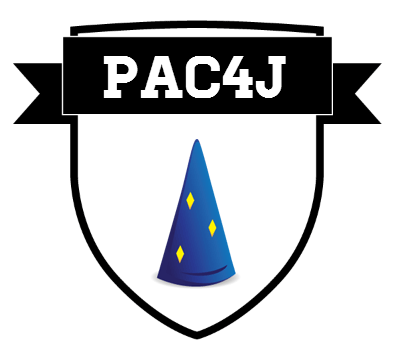A Dropwizard bundle for securing REST endpoints using pac4j.
dropwizard-pac4j provides two components which must be integrated into
applications:
- A configuration factory populated by values from a
pac4jsection within an application's config file. - A Dropwizard bundle
which:
- connects the values defined in the
pac4jconfiguration section to thejax-rs-pac4jandj2e-pac4jlibraries. - enables the use of the annotation provided in by the
jax-rs-pac4jlibrary. - enables Jetty session management by default.
- connects the values defined in the
You need to add a dependency on:
- the
dropwizard-pac4jlibrary (groupId: org.pac4j, version: 3.0.0) - the appropriate
pac4jsubmodules (groupId: org.pac4j, version: 3.0.0):pac4j-oauthfor OAuth support (Facebook, Twitter...),pac4j-casfor CAS support,pac4j-ldapfor LDAP authentication, etc.
All released artifacts are available in the Maven central repository.
Add the bundle within the application class' initialize method, just like any
other bundle:
public class MySecureApplication extends Application<MySecureConfiguration> {
final Pac4jBundle<MySecureConfiguration> bundle = new Pac4jBundle<MySecureConfiguration>() {
@Override
public Pac4jFactory getPac4jFactory(MySecureConfiguration configuration) {
return configuration.getPac4jFactory();
}
};
@Override
public void initialize(Bootstrap<TestConfiguration> bootstrap) {
bootstrap.addBundle(bundle);
}
...It can be useful to store the bundle in its own field in order to be able to access pac4j configuration as shown at the end of the next section.
Update the application's configuration class to expose accessor methods for
Pac4jFactory:
public class MySecureConfiguration extends Configuration {
@NotNull
Pac4jFactory pac4jFactory = new Pac4jFactory();
@JsonProperty("pac4j")
public Pac4jFactory getPac4jFactory() {
return pac4jFactory;
}
@JsonProperty("pac4j")
public void setPac4jFactory(Pac4jFactory pac4jFactory) {
this.pac4jFactory = pac4jFactory;
}
}Note that it is also possible to have pac4jFactory be nullable and in this
case, pac4j won't be configured but pac4j's type will be readable in the
configuration. If the latter is not desired, do not use this bundle!
Add a pac4j section to a Dropwizard application's configuration file:
pac4j:
# those protect the whole application at Jersey level
globalFilters:
- matchers: excludeUserSession
authorizers: isAuthenticated
servlet:
security:
- ...
callback:
- ...
logout:
- ...
matchers:
# this let the /user/session url be handled by the annotations
excludeUserSession:
class: org.pac4j.core.matching.PathMatcher
excludePath: ^/user/session$
callbackUrl: /user/session
defaultClient: DirectBasicAuthClient
clients:
- org.pac4j.http.client.direct.DirectBasicAuthClient:
authenticator:
class: org.pac4j.http.credentials.authenticator.test.SimpleTestUsernamePasswordAuthenticator-
globalFiltersto declare global filters: theclients,authorizers,matchers,multiProfileandskipResponseproperties directly map to the parameters used byorg.pac4j.jax.rs.filter.SecurityFilter. -
servletto declare servlet-level filters: -
security: theclients,authorizers,matchersandmultiProfileproperties directly map to the parameters used byorg.pac4j.j2e.filter.SecurityFilter. Themappingproperty is used to optionally specify urls to which this filter will be applied to, defaulting to all urls (/*). -
callback: thedefaultUrl,renewSessionandmultiProfileproperties directly map to the parameters used byorg.pac4j.j2e.filter.CallbackFilter. Themappingproperty is used to specify urls to which this filter will be applied to. It does not usually contains a wildcard. -
logout: thedefaultUrlandlogoutUrlPatternproperties directly map to the parameters used byorg.pac4j.j2e.filter.ApplicationLogoutFilter. Themappingproperty is used to specify urls to which this filter will be applied to. It does not usually contains a wildcard. -
sessionEnabled: set tofalseto disable Jetty session management. If not set, the bundle will simply enable it by default. -
matchers: the key is the name of theMatcherand its instance is declared as explained below. Their name can be used infilter'smatchersas well as in thePac4JSecurityannotation. -
authorizers: the key is the name of theAuthorizerand its instance is declared as explained below. Their name can be used infilter'sauthorizersas well as in thePac4JSecurityannotation. -
clients: the key is the class of theClientand its instance is configured based on the properties. Its name is by default the short name of its class, but it can also be set explictly. Their name can be used infilter'sclientsas well as in thePac4JSecurityannotation. -
defaultClient: the name of one of the client configured viaclients. It will be used as the default pac4jClient. Pac4j exploits it in particular when no client is specified during callback, but also when no clients are specified on a security filter. -
defaultClients: the names (separated by commas) of some of the clients configured viaclients. They will be used as the default value for theclientsparameter of thePac4JSecurityannotation.
To specify instances of Client, Authenticator, PasswordEncoder,
CredentialsExtractor, ProfileCreator, AuthorizationGenerator,
Authorizer, Matcher, CallbackUrlResolver, HttpActionAdapter
and RedirectActionBuilder, it only necessary to refer to their class name
using the class key as above and the other properties are set on the
instantiated object.
Note that all urls used within Jersey filters are relative to the dropwizard
applicationContext suffixed by the dropwizard roothPath while the urls used
within Servlet filters are only relative to the dropwizard
applicationContext.
For Jersey, this also includes callbackUrls, enforced by
JaxRsCallbackUrlResolver, which is the defaultCallbackUrlResolver in the
config if not overridden.
For more complex setup of pac4j configuration, the Config can be retrieved from
the Pac4jBundle object stored in your Application:
public class MySecureApplication extends Application<MySecureConfiguration> {
final Pac4jBundle<MySecureConfiguration> bundle = ...;
@Override
public void run(MySecureConfiguration config, Environment env) throws Exception {
Config conf = bundle.getConfig()
DirectBasicAuthClient c = conf.getClients().findClient(DirectBasicAuthClient.class);
c.setCredentialsExtractor(...);
env.jersey().register(new DogsResource());
}
}From here, jax-rs-pac4j takes over with its annotations. See pac4j
documentation on how to implement Clients, Authorizers, Matchers and all
the other points of extension.
When using ResourceTestRule, it usually make sense to mock the profile that
is injected for @Pac4jProfile annotations by using one of the alternative
Pac4JValueFactoryProvider binders:
@Rule
public final ResourceTestRule resources = ResourceTestRule.builder()
.addProvide(MyResource.class)
.addProvider(new Pac4JValueFactoryProvider.Binder(new CockpitProfile("my-mock-user-id")))
.build();See the release notes. Learn more by browsing the dropwizard-pac4j Javadoc and the pac4j Javadoc.
If you have any question, please use the following mailing lists:
The version 3.0.0-SNAPSHOT is under development.
Maven artifacts are built via Travis and available in the
Sonatype snapshots repository.
This repository must be added in the Maven settings.xml or pom.xml files:
<repositories>
<repository>
<id>sonatype-nexus-snapshots</id>
<name>Sonatype Nexus Snapshots</name>
<url>https://oss.sonatype.org/content/repositories/snapshots</url>
<releases>
<enabled>false</enabled>
</releases>
<snapshots>
<enabled>true</enabled>
</snapshots>
</repository>
</repositories>

